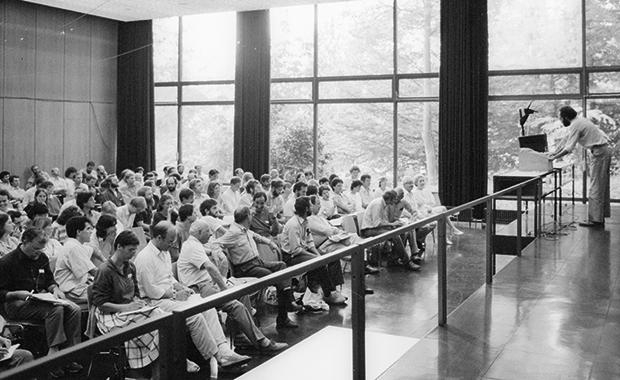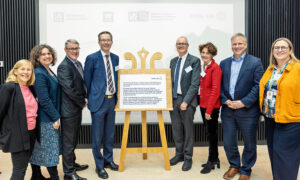
History in the making
From Albert Einstein’s love letters and Marie Curie’s scruffy lab notebooks to photos of graffiti scrawled on a wall by Francis Crick, archival material can provide an unparalleled treasure trove for historians to excavate the personal stories hiding behind the science. With the appointment of Anne-Flore Laloë as our first archivist, EMBL can start to chronicle the twists and turns and ups and downs of life at the Lab.

Carefully placing a cardboard box down in the middle of an empty room, Anne-Flore Laloë smiles to herself about the small piece of history she has just acquired. The container, home to a large collection of photographs donated by an EMBL alumnus, is one of the first contributions to the Laboratory’s new archive – a project to preserve and catalogue material that is often at risk of being forgotten and make it widely accessible. “There was a danger that a century from now we might look back and much of EMBL’s history would have been inadvertently lost,” says Laloë, who joined EMBL in January this year. “With this project, we are making sure that EMBL’s unique past and present is available to scientists, historians, philosophers and more in the future.”

Spurred by warnings from the academic community that the history of the molecular life sciences is at risk of vanishing unless active steps are taken to protect it, EMBL’s Alumni Association launched the archive initiative with the aim of safeguarding the Laboratory’s heritage. “This idea was really galvanised by EMBL’s 40th anniversary,” says Laloë. “EMBL has grown rapidly and represents a huge chapter in the history of molecular biology in Europe. Each person who leaves the Laboratory takes away a chunk of our story with them – but you can collect this, be proactive and make sure that your past and present is available for the future.
“Our goal is to collect unpublished, original material in whatever format it exists – letters, photographs, reports, notebooks, memoirs, lab books, memos, emails, article drafts, databases, official documents, you name it – and safeguard it for future generations. Archives take the user on a journey of discovery. You might unearth hidden stories, missing information, or inspirational ideas, as well as learn more about what people were actually thinking, feeling and doing at the time. One of my tasks is to find ways to contextualise the material we gather in connection with other science archives – such as at CERN, the Wellcome Trust, the Medical Research Council Laboratory of Molecular Biology, and many more – that collectively tell the wider narrative of the history of science in Europe. It’s an exciting feeling to think much of this awaits documentation and discovery.”

Deeper footprints
Cutting through the stereotype of a basement-dwelling academic whose only company is row upon row of dusty boxes, Laloë is outgoing, energetic and excited about her mission. She has already met with alumni and people across all EMBL’s sites, raising awareness and gathering ideas for what she describes as a big community project that belongs to everyone who has been part of the EMBL story. Her take home message for this large numbers of protagonists: “Throw nothing away! At least not before considering what you might have to offer the archive”.
“Imagine getting your hands on the original manuscript of a famous song, or an initial sketch of an influential painting – look hard enough and the same thing can be found in science,” she says. “Archived material can have huge social significance, ignite public interest and provide insights into how things really happened, enriching our understanding above and beyond the ‘official’ record. Scholars using the Royal Society archive in the UK, for example, have recently shed new light on the crucial role of women in practising, popularising and communicating science during Victorian times by comparing letters, documents and other rare materials with official literature. It revealed remarkable contributions that add new dimensions to our understanding of science during these times.”
Archived material can have huge social significance, ignite public interest and provide insights into how things really happened.
Laloë is quick to point out that such insights might come from something as unremarkable as a notebook, an article draft or a quickly scribed email. “We are looking for the ordinary as much as the extraordinary,” she explains. “The creativity of people who have access to archives is mind-blowing – seemingly innocuous notes might inspire plays, songs, books and poems – while at the same time this information can deliver important clues in understanding how certain ideas are generated. What changed between the first draft and the published version? How did the thinking evolve along the way? Why did you circle that paragraph with red ink seven times? All of this information is cocooned in everyday material, both analogue and digital.”

How can you contribute?
If you feel you have something to offer EMBL’s archive, Laloë urges you to get in touch with her as she can offer advice on ways to effectively capture the information, as well as discussing aspects such as access rights and confidentiality. “Sometimes I meet with people and the first thing they will do is look around their office and say ‘as you can see I do not have much here!’” she explains. “But everyone has their own personal archive – it might be a filing cabinet, a box of photographs at the bottom of a cupboard, or document folders on a laptop. These items might seem irrelevant to you, but they could be of significant importance to the collective memory of EMBL. Anything that you donate in confidence will remain so.”
The archive will be active and modern, continuously growing and evolving.
The first item to be deposited in the archive came with a certain amount of humour – EMBL Director General Iain Mattaj donated a laser pointer that stopped working during the launch of the concept in 2010. Among the first collections to be processed this year will be those of former Director General Fotis Kafatos and former Head of Core Facilities and Services Christian Boulin, each representing a different facet of EMBL’s activities. Other items include a copy of the original proposal for EMBL from 1967, technical illustrations from EMBL’s Core Facilities, a box of official and social photographs, and a commemorative flag from EMBL’s 40th anniversary celebrations (see icons). But Laloë is on the hunt for much more. “The material that we look after might be frozen in time, but our activities are not,” she says. “The archive will be active and modern, continuously growing and evolving. There is a massive resource to be tapped in terms of both material and knowledge – ultimately we want to create a resource that is comprehensive, easy to navigate and accessible to scholars the world over.”
One challenge lies in getting people to recognise the value of their material, particularly in the digital era when data can be deleted at the touch of a button. “While the medium has changed, the essence of the conversation hasn’t – people think that letters were only full of important information, while in fact they could be just as informal as today’s emails,” she explains. “I once read a letter from a taxonomist to his colleague. He ended the note with a complaint bemoaning the fact that his servant was ill and he was being forced to eat out everyday – poor him! We can learn a lot from these interactions. It’s the personal meeting the scientific, and letters of the past are not much different to the email exchanges that we have nowadays.”

Creating excitement
Laloë, who holds a PhD in Geography, joined EMBL from the Marine Biological Association of the UK, where she was responsible for the Association’s varied historical collections. This included a herbarium, with specimens dating back to the 1800s. “Specimens were often beautifully preserved in albums, the colours as brilliant today as when they were collected. But by teasing out the accompanying letters, we were able to learn more about what life was like for collectors, or where a rare species was first spotted. It is interesting to try and imagine, a century from now, how people will look at the work we are doing today at EMBL, and then be able to understand who did what and why. Whether it is a specimen of seaweed, or a re-jigged machine that enables you to focus on something specific, you give a voice to the person who was there in the first place. It is like a time capsule.”
A first practical step is to create the database and begin cataloguing in earnest before the year is out, creating an interface that will make the archive accessible to the world. “Someone might want to know what the first Annual Report of EMBL looked like, learn more about the first Director General, or how the Staff Association was founded,” she adds. “Or it might be that a neat sketch from a researcher can be used in a presentation to school children. The success of the project, and the eventual shape that the archive will take is entirely dependent on what people are willing and able to give us. And that’s the other side to it: our archive is a resource to get people excited about EMBL and the personal stories that are the essence of scientific life.”



